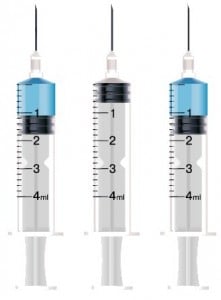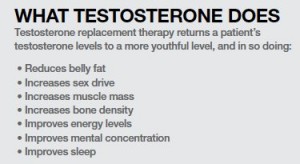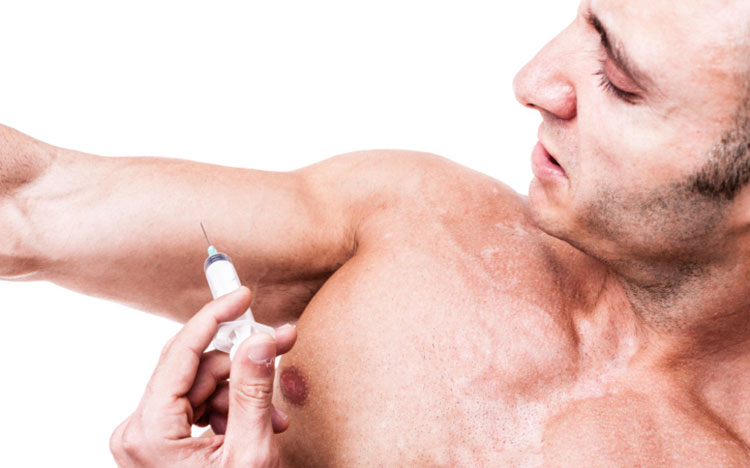By: James Broida
When it comes to hormone replacement therapy for men, almost all agree that testosterone is key. The question is: what’s the best way to take it?
Of all the anti-aging therapies today, bio-identical hormone replacement in the form of testosterone seems to be the quickest to enter the mainstream. Already it’s appearing in commercials for late-night shows and sports programs, places where, presumably, men worried about low testosterone hang out.
The principle is a fairly simple one: When men are young and vigorous and full of sexual energy, they have a high level of testosterone. As men get older, their testosterone levels, along with their vitality, decline. Replace that testosterone and their mental and physical energy returns—along with such manly things as muscle mass and bone strength.
Testosterone is also important for women, who are highly sensitive to the hormone, even though their bodies make about one tenth as much as men. Hormone replacement for them also increases muscle mass, bone density and energy levels. For both men and women adequate testosterone promotes lean body mass, decreases visceral fat, and decreases total cholesterol. Inadequate, low levels increase your chances of high blood pressure, heart attacks, obesity, osteoporosis, Alzheimer’s disease and other age-related illnesses.
“I believe that every patient over the age of 35 will benefit from bio-identical hormone replacement,” says Leonard Rubenstein, MD, an anti-aging and cosmetic physician in Sarasota, Fla. “You will end up with a healthier, happier patient.”
Low Testosterone Treatment
One of the big questions, however, is not whether you need testosterone, or how much you need (these can be determined with blood, urine and/or saliva tests) but how to get the testosterone into your system. There are three main ways—via topical cream, via injections or via a pellet put into your body—with physicians recommending one or the other.
Dr. Jean-Claude Nerette, Jr., of the Bellissimo Spa in Weston, Fla., believes that the best approach is to put a testosterone pellet under the patient’s skin. This ensures a steady release of the hormone over time, while avoiding the potentially unpleasant task of injecting yourself with a syringe.
“Pellets provide a slow, sustained release 24/7,” says Dr. Nerette. If your body needs more testosterone, it gets more, through the simple mechanism of increased circulation. “When you increase blood flow past the pellet—when your heart rate is greater—then your body will take more,” he says.
Dr. Nerette believes that for men in particular the creams do not provide enough testosterone because of problems absorbing it through the skin. And as for the needle, Dr. Nerette believes it provides a spike right after you use it, with levels then dissipating as you wait for the next needle. “When you inject on Monday they [your test levels] are super high. By end of week they are crashing again,” he says.
Female Hormone Options and Benefits
Pellets are also useful for women, with the amount adjusted accordingly. “I am able to customize the pellet for a patient’s weight and age,” says Dr. Ferdinand Cabrera, an anti-aging doctor who practices in Fort Lauderdale, Fla. “If the woman is between 40 and 45, say, or between 55 and 60, I am able to precisely determine the amount of testosterone needed.”


Not every doctor believes in the pellet approach. Andre Berger, MD, an anti-aging and cosmetic physician in Beverly Hills, says that he prefers the syringe for testosterone because it allows patients to control their dosage. Once a pellet is put in, it delivers the same dosage for up to six months; this means you really can’t adjust levels along the way.
That may be a benefit, says Dr. Cabrera, because then patients can’t give themselves more than necessary. “If the goal is to restore the balance and the hormone levels to where they were [at a younger age],” he says, “with the pellet I’m assured that I can give them these levels without overdosing whatsoever.”
Dr. Nerette says you can get a pretty good idea early on as to a patient’s requirements, and that the first pellet lasts only three months, so you can then make adjustments if needed. There is also the issue of expense: Pellets cost more at first, because a procedure is involved, while injectable testosterone costs more each month ($200 compared to $100).
Regardless of how the testosterone is delivered, most anti-aging doctors are in complete accord as to the benefits. “Testosterone replacement therapy can combat erectile dysfunction, loss of muscle tone, increased belly fat and loss of concentration,” says Dr. Nerette. “But the most important thing is that testosterone is one of the hormones associated with mortality. If it’s low in a man, he is more likely to die from heart attack or stroke.”
“It’s impossible as a holistic doctor to avoid hormone balancing,” says Dr. Rubenstein. “Testosterone is good for both men and women. It is a vital hormone with many, many benefits, including for the brain, bones, muscle and blood.” Even if your goal is merely aesthetic, points out Dr. Rubenstein, “Everything we can do to help the patient achieve an optimal state of wellness will benefit the patient’s cosmetic procedures.”













